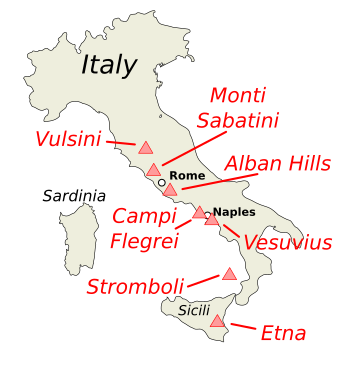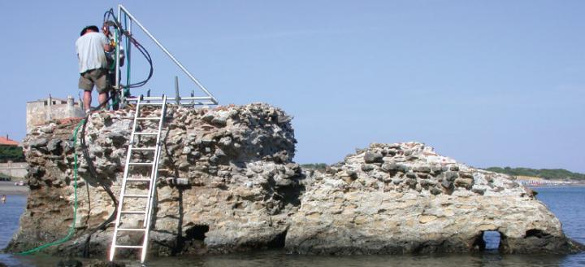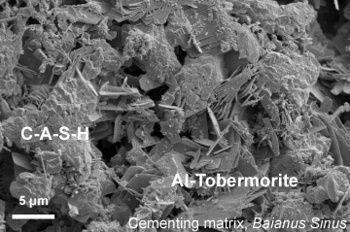Roman Concrete
August 7, 2017
Astronomy was well-developed in
antiquity, since the
dome of heaven was quite mysterious, and it demanded serious study. However, there's not much detail that can be discerned with the
unaided eye, so knowledge of the
stars started with a few facts, and then it developed into
speculative areas such as
astrology. In contrast,
materials science allowed
experiment with the primitive
processing tools available the time, and the product of such
science was often useful.
Because of the ubiquity and general utility of
stone, stone tools persisted for quite a while. The
Stone Age of
human culture persisted for a little more than 3 million years.
Metalworking began in earnest about 2,000
BC, and the
ancients were quite good at
metallurgy, since
metals were easy to form into
vessels,
works of art; and, of course,
weapons. The first metals to be worked were those like
gold,
silver, and
copper that existed as
native metal in
ores.
Eventually, other metals, such as
iron, were released from ores by
smelting, so we have a progression of useful metals as
the ages of Man, expressed by the
Greek poet,
Hesiod, in his
Works and Days; namely, Gold, Silver,
Bronze, and Iron. Hesiod viewed the diminished value of the metals in this progression as a reflection of the degeneration of the state of man from a golden age, to a crass age of iron.

Hesiod, Works and Days, lines 175-176. "For now truly is a race of iron, and men never rest from labor and sorrow by day, and from perishing by night; and the gods shall lay sore trouble upon them." (Greek and English translation from Project Perseus, Tufts University.)[1
Still, Man was quickly able to refine his metallurgy even in this bleak age of iron to produce some incredible
artifacts. The 1600 year old
Iron pillar of Delhi, India, is a 6.5
ton iron
stele about seven
meters (23
feet) high that tapers from a
diameter of about a meter at its base to about 0.7 meters at the top. This object has high
corrosion resistance, a consequence of the iron's high
phosphorous content, induced by the phosphorus content of the firing
wood. Phosphorous is one of the ingredients of
CORTEN steel, a modern
alloy that's
passivated by a phosphorous phase. The
composition of CORTEN-A is
FexC0.12Si0.25-0.75Mn0.20-0.50P0.07-0.15S0.03Cr0.50-1.25
Cu0.25-0.55Ni0.65.
If you look around the world, most of what you see isn't metal, it's
concrete. In 2007, members of
The Materials Society (TMS), declared that concrete was the sixth most important
material in history.[2]
John Smeaton is credited with inventing modern concrete in 1775, but the
ancients were using concrete mixtures long before that. Some of this ancient concrete was superior to modern concrete in
durability, surviving 2,000 years of
seawater attack and
wave action, and its manufacture was
environmentally friendly. I wrote about ancient concrete in an
earlier article ("In Search of... Ancient Concrete," July 1, 2013).
An early mention of concrete is found in
de Architectura by the
Roman civil engineer and
military engineer,
Vitruvius (c. 75 BC - c. 15 BC), as follows (
Latin text from ref. 3. The translation is my own)[3]
Est etiam genus pulveris quod efficit naturaliter res admirandas. nascitur in regionibus Baianis et in agris municipiorum quae sunt circa Vesuvium montem. quod commixtum cum calce et caemento non modo ceteris aedificiis praestat firmitatem, sed etiam moles cum struuntur in mari, sub aqua solidescunt. (de Architectura, 2.6.1)
There is a type of sandy earth that, because of its nature, produces wonderful results. It is native to the region of Baiae, and the fields and cities around Mount Vesuvius. This material, when mixed with lime and rubble, not only gives strength to buildings, but also to breakwaters set in the sea, and it solidifies underwater.
The mention of the
volcano, Mount Vesuvius, famous for its
79 AD eruption that buried
Pompeii, gives a quick clue as to how the ancients created such concrete without today's
technology. A large international team of
scientists from the
University of Utah (Salt Lake City, Utah),
Western Washington University (Bellingham, Washington),
Southeast University (Nanjing, People's Republic of China),
Xi'an Jiaotong University (Xi'an, People's Republic of China),
Harbin Institute of Technology (Harbin, People's Republic of China), the
Università degli Studi di Napoli Federico II (Naples, Italy), and the
University of California (Berkeley, California) has just published a thorough study of this ancient concrete.[4-8]

Volcanic sites in Italy.
(Base map Via Wikimedia Commons. Data from Ref. 4)[4
Modern concrete is based on
Portland cement, a material that's processed at high
temperatures (>1,300 °C). Such processing involves a severe
environmental burden, since the making of cement is responsible for about 5% of global
carbon dioxide (CO
2) emissions.[7] The
Roman concrete was made from
volcanic ash, lime (
calcium oxide, CaO), and
seawater, and the only
energy needed is for heating of
limestone to make lime.[5] These three ingredients react together in what's called a
pozzolanic reaction, named after the city of
Pozzuoli in the
Gulf of Naples.[6] Roman
historian,
Pliny the Elder, wrote in his
Naturalis Historia that this concrete becomes "a single stone mass, impregnable to the waves and every day stronger."[6]

Imagine Pliny in short pants. This is a pier at Portus Cosanus in Orbetello, Italy. The Roman concrete of this structure has been carefully studied at Lawrence Berkeley National Laboratory. (DOE/Lawrence Berkeley National Laboratory image by J.P. Oleson.
While modern concrete
corrodes, especially in the presence of sea water, this ancient concrete appears to strengthen from exposure.[7] The key to this concrete's
millennial stability is its growth of
crystals of
aluminum tobermorite and
phillipsite which are arrayed as fine, interlocking
fibers and plates that resist
fracture.[5] Underwater volcanoes, such as the
Surtsey Volcano in
Iceland, produce these same minerals.[5]
The research team suggests that a concrete recipe based on Roman concrete could be useful for construction of modern seawalls and other ocean-facing structures.[5] It's presumed that the lime and volcanic ash were completely reacted at the start, but a period of aluminum tobermorite and phillipsite formation continued.[5] Such a
formulation might also be useful for safeguarding
hazardous waste.
Radioactive waste needs to be kept stable under extreme environments for long times.[5]

Plates of aluminum tobermorite in a calcium-aluminum-silicate-hydrate (C-A-S-H) matrix.
(University of Utah image by Marie Jackson.
Concrete is big
business, with sales of about $50 billion in the US alone in 2015.[5] Portland cement production was about 80.4 million tons in 2015, the equivalent of twelve
Hoover Dams.[5] Since the energy requirement for production of Roman concrete is smaller, there would be a considerable environmental saving.[7] However, there are impediments to modern production of Roman concrete, not the least of which is the availability of suitable volcanic rocks.[7] Also, the precise
recipe is not known.
Marie D. Jackson, lead
author of the
paper and a
professor of
Geology and Geophysics at the University of Utah, has searched through ancient Roman texts to find the recipe, to no avail.[6]
Nevertheless, Jackson is mixing seawater from the
San Francisco Bay and volcanic rock from the
Western United States to find the right formula.[5-6] Even if a proper mixture can be found, there's the problem that Roman concrete develops its strength over time, and it has an initial
compressive strength that's smaller than that of modern concrete.[6] This work was funded by the
United States Department of Energy's Office of Science, and the
National Science Foundation.[5]
References:
- Hesiod, "Works and Days," Hugh G. Evelyn-White, Trans., Harvard University Press (Cambridge, MA., 1914), ll. 175-6, via Project Perseus, Tufts University.)
- The Top 50 Moments in History, TMS web site, February 26, 2007.
- Vitruvius, "De Architectura," Latin Text by Valentin Rose (Teubner, 1899), via University of Chicago Penelope Web Site.
- Marie D. Jackson, Sean R. Mulcahy, Heng Chen, Yao Li, Qinfei Li, Piergiulio Cappelletti, and Hans-Rudolf Wenk, "Phillipsite and Al-tobermorite mineral cements produced through low-temperature water-rock reactions in Roman marine concrete," American Mineralogist, vol. 102, no. 7 (July, 2017), DOI: 10.2138/am-2017-5993CCBY. This is an open access publication with a PDF file here.
- New Studies of Ancient Concrete Could Teach Us to Do as the Romans Did, UC Berkeley Press Release, July 3, 2017.
- How seawater strengthens Roman concrete, University of Utah Press Release, July 3, 2017.
- Matt McGrath, "Scientists explain ancient Rome's long-lasting concrete," BBC, July 4, 2017.
- How seawater strengthens Roman concrete, University of Utah YouTube Video, July 3, 2017.
Permanent Link to this article
Linked Keywords: Astronomy; ancient history; antiquity; celestial sphere; dome of heaven; naked eye; unaided eye; star; speculative reason; speculative; astrology; materials science; experiment; chemical process; processing tools; science; rock (geology); stone; Stone Age; human culture; metalworking; Anno Domini; BC; Ancient Greece; ancients; metallurgy; metals; vessel; work of art; weapon; gold; silver; copper; native metal; ore; iron; smelting; The Metallic Ages of Hesiod; the ages of Man; Greek; poet; Hesiod; Works and Days; Bronze; Project Perseus, Tufts University; artifact; Iron pillar of Delhi, India; ton; stele; meter; foot; diameter; corrosion resistance; phosphorous; wood; weathering steel; CORTEN steel; alloy; passivation (chemistry); passivated; composition of CORTEN-A; concrete; The Materials Society; material; John Smeaton; durability; seawater; wave action; environmentally friendly; de Architectura; Ancient Rome; Roman; civil engineer; military engineer; Vitruvius (c. 75 BC - c. 15 BC); Latin; Mount Vesuvius; lime (material); strength of materials; building; breakwater; ocean; sea; volcano; eruption of Mount Vesuvius in 79 AD; Pompeii; technology; scientist; University of Utah (Salt Lake City, Utah); Western Washington University (Bellingham, Washington); Southeast University (Nanjing, People's Republic of China); Xi'an Jiaotong University (Xi'an, People's Republic of China); Harbin Institute of Technology (Harbin, People's Republic of China); Università degli Studi di Napoli Federico II (Naples, Italy); University of California (Berkeley, California); volcanic; Italy; Wikimedia Commons; Portland cement; temperature; environmental; carbon dioxide; Roman concrete; volcanic ash; calcium oxide; seawater; energy; limestone; pozzolanic reaction; Pozzuoli; Gulf of Naples; historian; Pliny the Elder; Naturalis Historia; short pants; pier; Cosa; Portus Cosanus; Orbetello, Italy; Roman concrete; Lawrence Berkeley National Laboratory; J.P. Oleson; corrode; millennia; crystal; aluminum; tobermorite; phillipsite; fiber; fracture mechanics; fracture; Surtsey Volcano; Iceland; formulation; hazardous waste; radioactive waste; calcium; silicate; hydrate; matrix (geology); Marie Jackson; business; Hoover Dam; recipe; author; scientific literature; paper; professor; Geology and Geophysics at the University of Utah; San Francisco Bay; Western United States; compressive strength; United States Department of Energy; Office of Science; National Science Foundation.